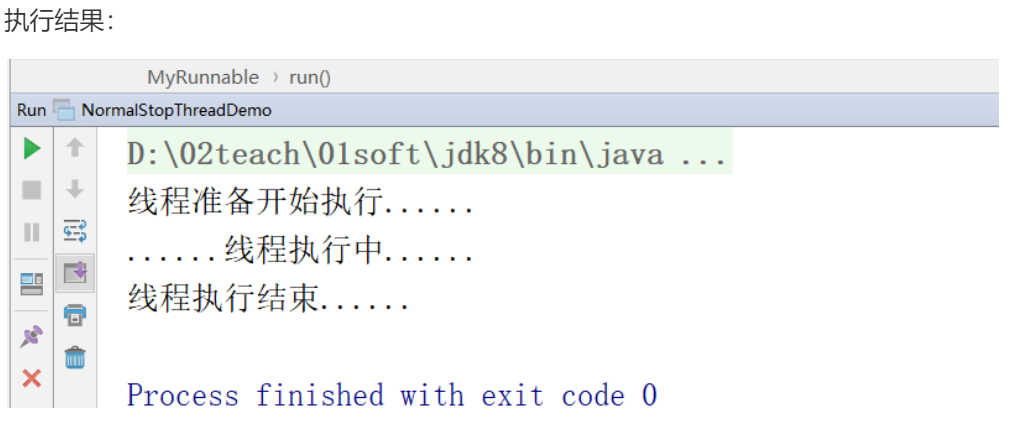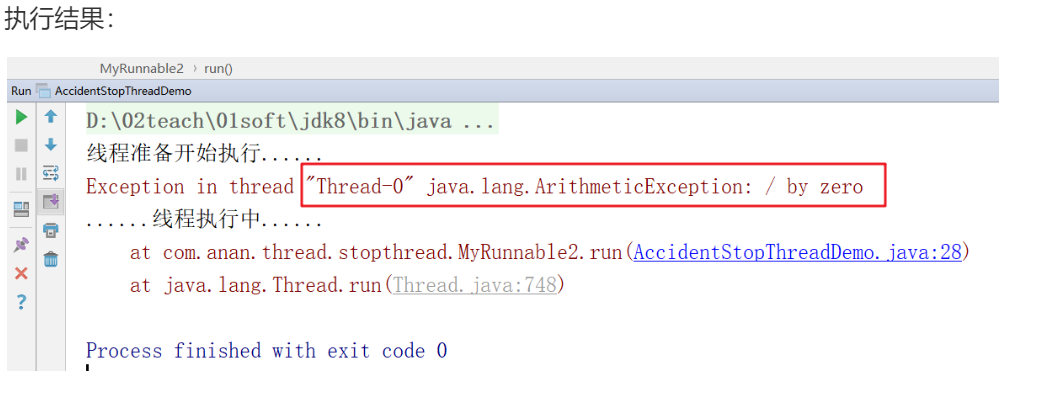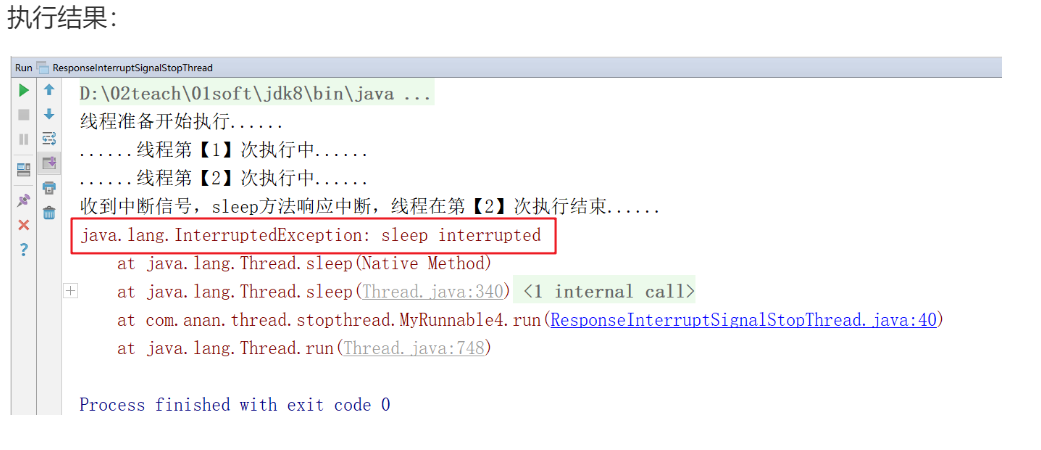线程八大基础核心三(停止线程)
在java多线程并发编程中,有八大基础核心。考考你:
看看都有哪八大基础核心呢?它们分别是:
1.创建线程的方式
2.线程启动
3.线程停止
4.线程生命周期
5.线程相关的方法
6.线程相关的属性
7.线程异常处理
8.线程安全
今天我们从第三个基础核心开始:停止线程
#前情回顾:
在java编程语言中,线程停止指的是线程的生命周期结束,分为正常执行结束和意外结束。
#考考你:
1.在java编程语言中,线程停止的情况有哪些?
2.在java编程语言中,如何人为优雅的停止线程?
3.在java编程语言中,为什么说坚决不要调用stop方法停止线程?
1 package com.anan.thread.stopthread; 2 3 /** 4 * 启动线程,调用run方法执行,当run方法正常执行结束,则线程正常停止 5 */ 6 public class NormalStopThreadDemo { 7 8 public static void main(String[] args) { 9 // 创建线程对象 10 Runnable r1 = new MyRunnable(); 11 Thread t1 = new Thread(r1); 12 13 // 启动线程 14 t1.start(); 15 16 } 17 } 18 19 /** 20 * 实现Runnable接口,创建线程 21 */ 22 class MyRunnable implements Runnable{ 23 24 public void run() { 25 System.out.println("线程准备开始执行......"); 26 System.out.println("......线程执行中......"); 27 System.out.println("线程执行结束......"); 28 } 29 }

1 package com.anan.thread.stopthread; 2 3 /** 4 * 启动线程,调用run方法执行,当run方法发生异常后,则线程意外停止 5 */ 6 public class AccidentStopThreadDemo { 7 8 public static void main(String[] args) { 9 // 创建线程对象 10 Runnable r1 = new MyRunnable2(); 11 Thread t1 = new Thread(r1); 12 13 // 启动线程 14 t1.start(); 15 16 } 17 } 18 19 /** 20 * 实现Runnable接口,创建线程 21 */ 22 class MyRunnable2 implements Runnable{ 23 24 public void run() { 25 System.out.println("线程准备开始执行......"); 26 System.out.println("......线程执行中......"); 27 // 发生意外 28 int i = 1/0; 29 30 System.out.println("线程执行结束......"); 31 } 32 }

1 package com.anan.thread.stopthread; 2 3 import java.util.concurrent.TimeUnit; 4 5 /** 6 * 启动线程,调用run方法执行,通过线程对象调用interrupt中断方法,发送中断信号停止线程 7 */ 8 public class InterruptSignalStopThread { 9 10 public static void main(String[] args) throws InterruptedException { 11 // 创建线程对象 12 Runnable r1 = new MyRunnable3(); 13 Thread t1 = new Thread(r1); 14 15 // 启动线程 16 t1.start(); 17 // 主线程休眠1毫秒后,向t1线程发送中断信号 18 TimeUnit.MILLISECONDS.sleep(1); 19 t1.interrupt(); 20 } 21 } 22 23 /** 24 * 实现Runnable接口,创建线程 25 */ 26 class MyRunnable3 implements Runnable{ 27 28 public void run() { 29 System.out.println("线程准备开始执行......"); 30 // 循环执行任务,直到收到中断信号为止 31 // isInterrupted()方法,返回线程是否被中断 32 int i = 0; 33 while ( ! Thread.currentThread().isInterrupted()){ 34 i++; 35 System.out.println("......线程第【" + i +"】次执行中......"); 36 } 37 System.out.println("收到中断信号,线程在第【" + i + "】次执行结束......"); 38 } 39 }

1 package com.anan.thread.stopthread; 2 3 import java.util.concurrent.TimeUnit; 4 5 /** 6 * 启动线程,调用run方法执行,在run方法中有可响应中断的操作, 7 * 比如:sleep、wait等。通过线程对象调用interrupt中断方法,发送中断信号响应中断停止 8 */ 9 public class ResponseInterruptSignalStopThread { 10 11 public static void main(String[] args) throws InterruptedException { 12 // 创建线程对象 13 Runnable r1 = new MyRunnable4(); 14 Thread t1 = new Thread(r1); 15 16 // 启动线程 17 t1.start(); 18 // 主线程休眠1毫秒后,向t1线程发送中断信号 19 TimeUnit.MILLISECONDS.sleep(1); 20 t1.interrupt(); 21 } 22 } 23 24 /** 25 * 实现Runnable接口,创建线程 26 */ 27 class MyRunnable4 implements Runnable{ 28 29 public void run() { 30 System.out.println("线程准备开始执行......"); 31 // 循环执行任务,直到收到中断信号,通过sleep方法响应中断 32 int i = 0; 33 try{ 34 35 while ( i <= 100000000){ 36 i++; 37 System.out.println("......线程第【" + i +"】次执行中......"); 38 39 // 休眠10毫秒 40 TimeUnit.MILLISECONDS.sleep(10); 41 } 42 }catch (InterruptedException e){ 43 System.out.println("收到中断信号,sleep方法响应中断,线程在第【" + i + "】次执行结束......"); 44 e.printStackTrace(); 45 } 46 47 } 48 }

#考考你答案:
1.在java编程语言中,线程停止的情况有哪些?
1.1.在java编程语言中,线程停止的情况有:正常停止、意外停止、中断停止
1.2.在实际项目开发中,我们追求正常停止、中断停止。避免意外停止
2.在java编程语言中,如何人为优雅的停止线程?
2.1.在java编程语言中,通过调用线程对象的interrupt()方法,发送中断信号的方式,人为优雅的停止线程
2.2.所谓人为优雅,即指与线程协商的方式停止线程,而不是强制停止线程,最终的停止权交由线程本身来控制
3.在java编程语言中,为什么说坚决不要调用stop方法停止线程?
3.1.因为如果使用stop方法停止线程,它是一种暴力手段,即强制停止线程,有可能会导致线程任务执行的不完整,不安全。且在较新版本的jdk中,已经设置为过期的方法,不再推荐使用。
#参考截图,来自jdk1.8

我们唯一能够控制的是自己的脾气和努力




 浙公网安备 33010602011771号
浙公网安备 33010602011771号